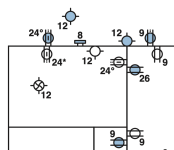That's how it's usually done here, too. My house has 20amps in the baths and garage which is nice. And in the laundry room.
I took the time, in this house and the last, to go through every outlet and fixture and appliance and trace it back to which breaker it's wired. Then I created a "map" of my home's electrical system, which includes the breaker scheme along with which outlets are 15A and which are 20A, which are GFI and which are wired to the load side of GFI outlets (and much more, of course). For example, I learned that every one of my bathrooms are wired to a single GFI in my master bath, even though one of those baths is almost 100' away!
I use it often (as I do a lot of electrical customizing) and it assists in plotting out what to plug in where, or what breaker to turn off when I need to. For example, I run a lot of power in my office (many computers and large printers), plus lots of power tools in the garage and yard, and a couple space heaters, etc. I refer to my map to know where I should and shouldn't plug in my high-watt devices, either permanently or temporarily.
This really should be something the original contractor provide, but instead, at best, you might get a half-baked set of illegible scribbles in your breaker box, that might even be correct some of the time!
Here's a chunk of my map, my master bath and just outside of it. Elsewhere on my map is a key that reminds me what all the symbols mean. The numbers are the circuit breakers.
View attachment 537739
It's about a half-day of work (not counting geeking it all out with Adobe Illustrator), but I used the first one I did for about 35 years, and I figure I'll get about the same out of this house's version. I keep a copy in the breaker box and one on my intranet so I can access it anytime from any device.
If you take the time to do something like this, be prepared to learn just how lazy/cheap your electrical contractor was!!



